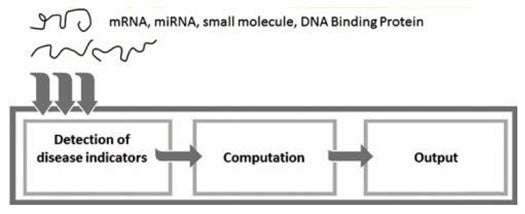An Israeli Biocomputer Can Now Detect Multiple Signs of Disease from Inside the Body
Wouldn’t it be easier to deal with disease if our bodies just fixed themselves? That’s asking quite a bit from...

Wouldn’t it be easier to deal with disease if our bodies just fixed themselves? That’s asking quite a bit from our physiologies, but Israeli researchers are working on tiny nano-computers that could do the job for us. They envision tiny machines made of biomolecules that autonomously troll the body looking for disease, computing a diagnosis and delivering drugs all at the same time. It’s a long way off, but they’re making progress–they’ve just developed a biomolecular computer that can autonomously identify multiple molecules at the same time.
From a biomolecular computing standpoint (as well as from a diagnostics standpoint), that’s pretty huge. The researchers have previously demonstrated a biomolecular computer that could sense disease indicators one at a time. Existing in a two state system, it essentially was programmed in a “yes” state for a certain disease indicator. It then performed a series of computation steps, checking for one mRNA disease indicator after another.
If all the indicators of a certain disease are present, the biocomputer would end unchanged in the same “yes” state. If any of the indicators were not present, it would end in a “no” state. It was rudimentary, but it was a diagnosis if an imperfect one.
The breakthrough here is that the team’s biocomputer now can now detect disease indicators from a variety of sources–mRNA, miRNA, proteins, and a variety of small molecules like ATP. The new biocomputer also needs fewer interactions with disease indicators and is designed with fewer moving parts.
The idea is to someday create swarms of biomolecular nano-computers that can autonomously and continuously patrol our bodies for the signs of disease. Because they can now detect indicators from more than one source, diagnoses would be more accurate. And with more and better computation, the biomachines could also deliver the first round of preventative drugs to the site of burgeoning disease, acting as a first line of defense against infection.
Of course, all this is years–decades, really–away. The idea that of nanomachines–even ones constructed of biomolecules–swimming our bloodstreams loaded up with drug payloads is a bit anxiety-inducing. What if they malfunction or misdiagnose? What if they were to accidentally release too much of a drug at the wrong place at the wrong time, or to inadvertently mix the wrong drugs into a harmful pharmaceutical cocktail?
You might lose sleep at night wondering what the tiny machines inside of you were up to. Even so, the idea of constant, vigilant, autonomous oversight of every organ in the body is pretty tantalizing.